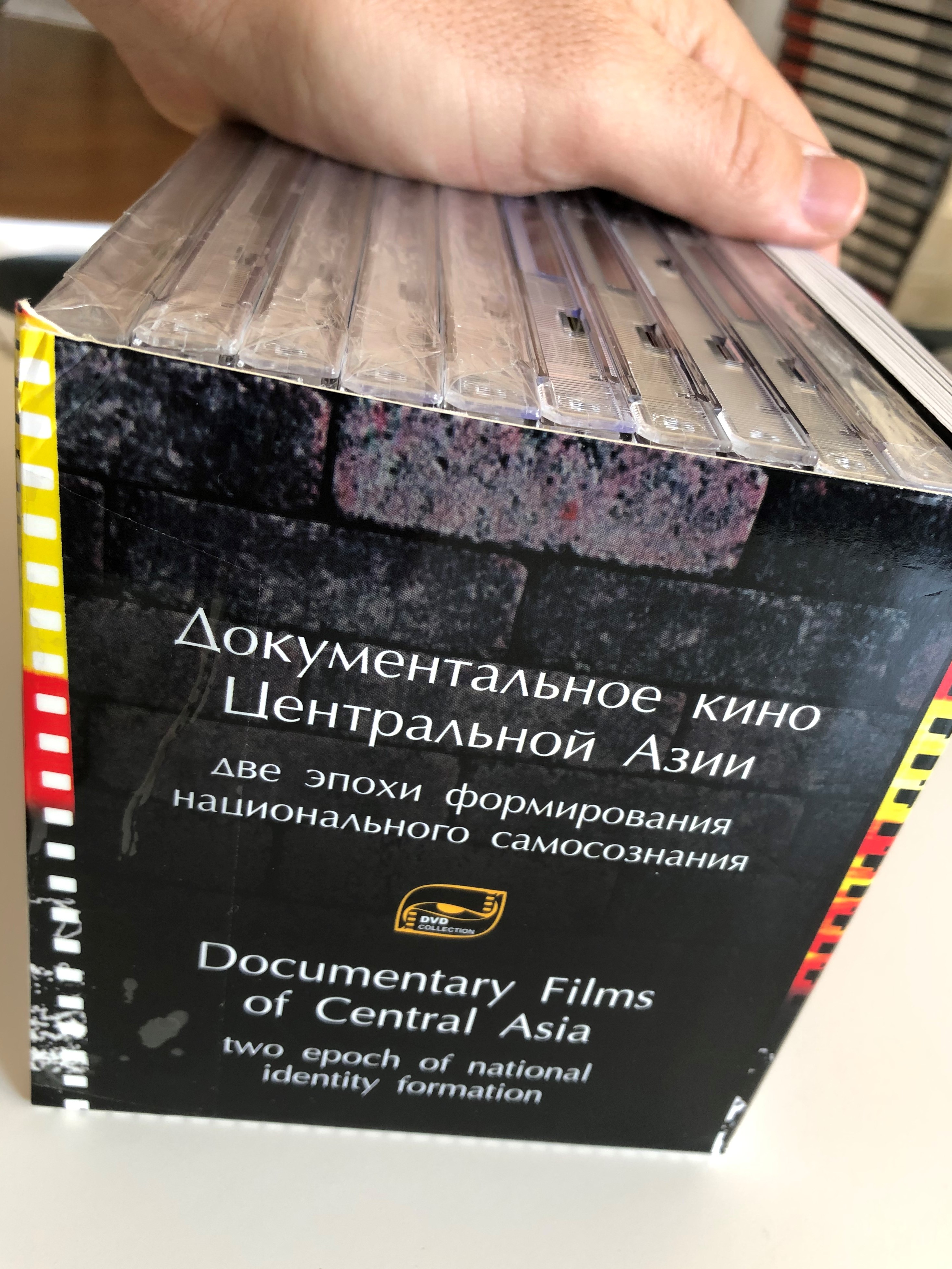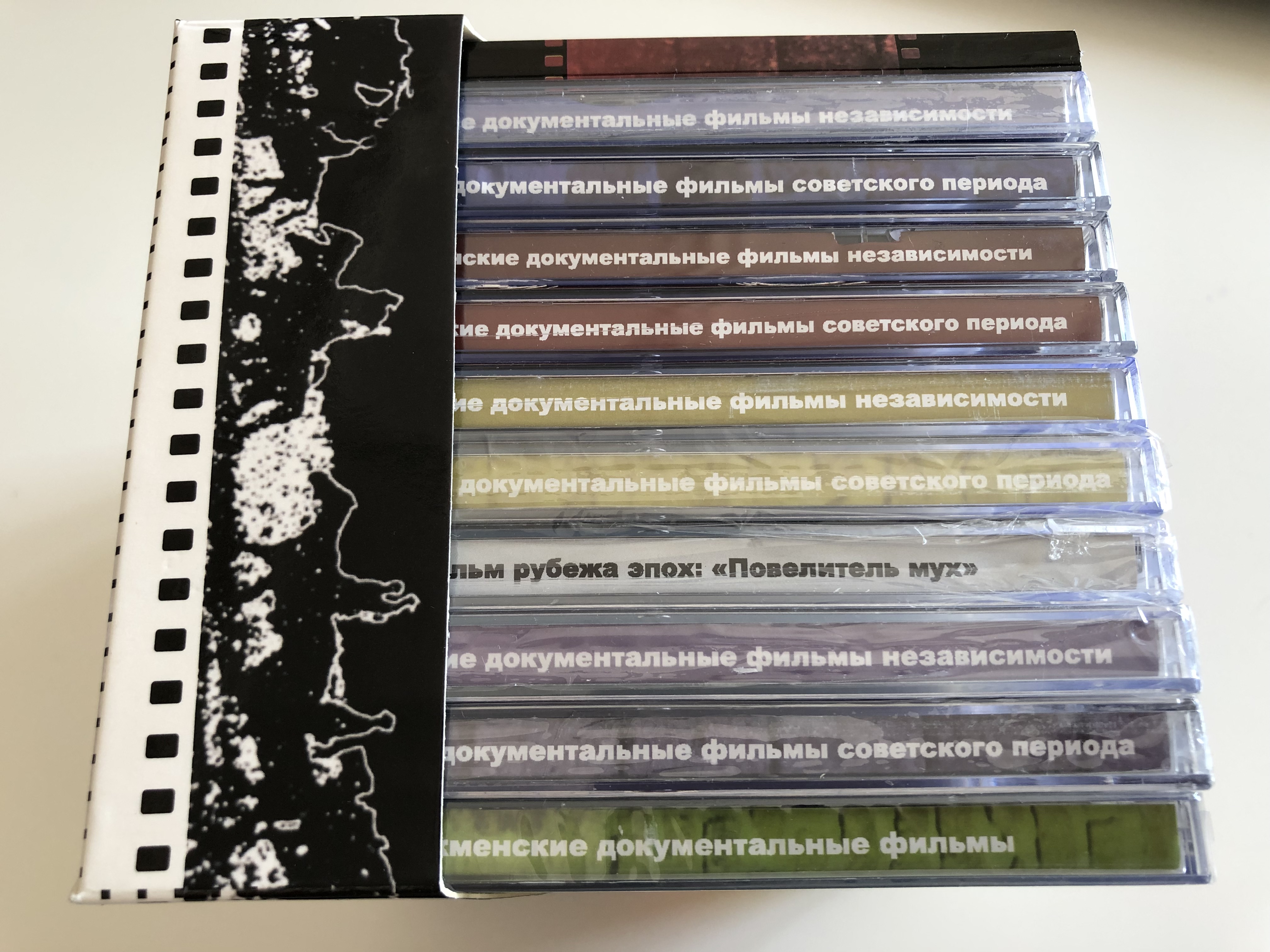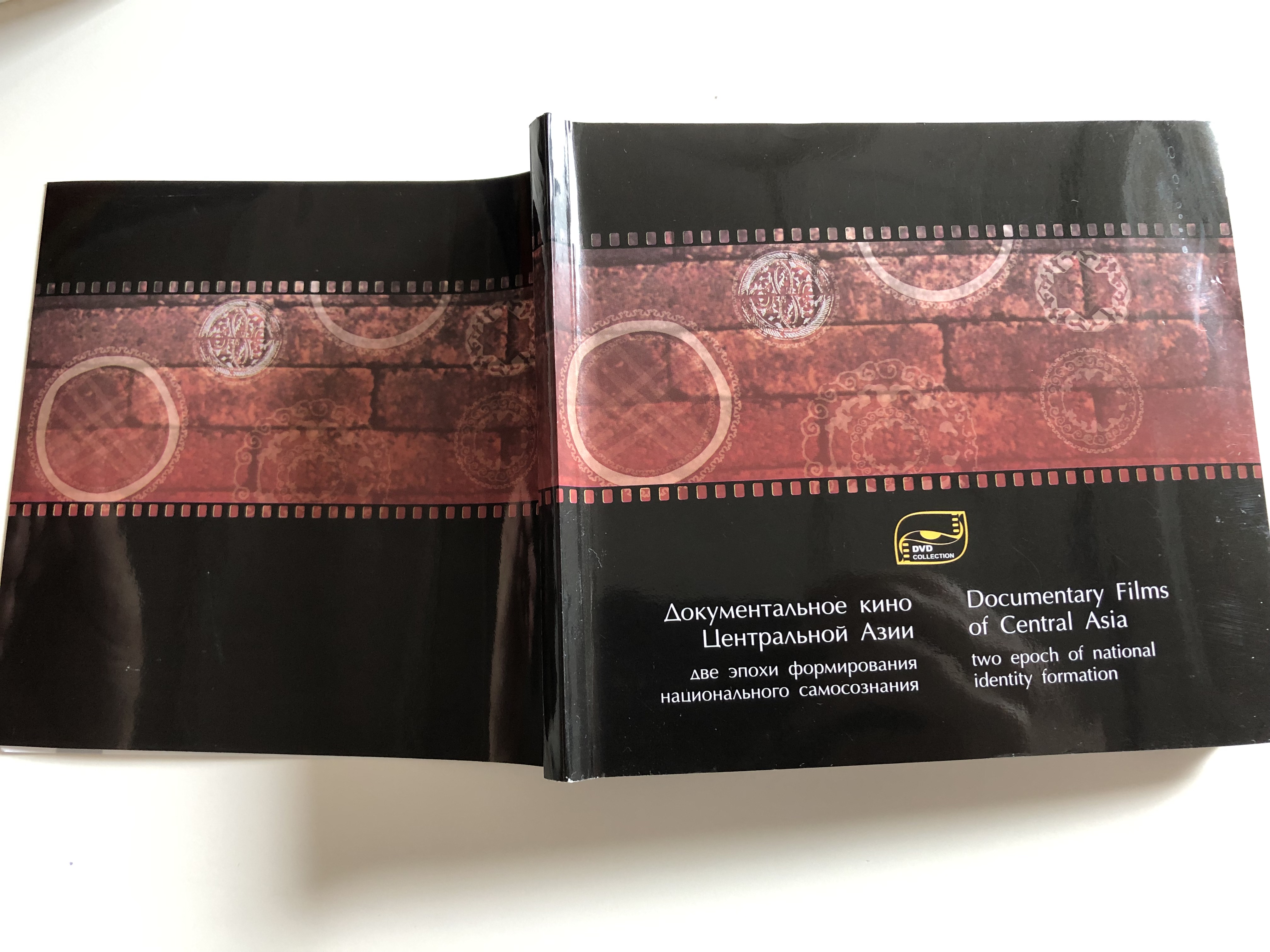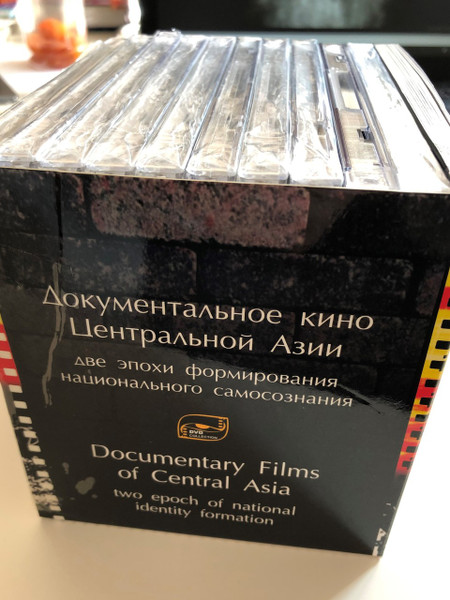Product Overview
Documentary Films of Central Asia two epoch of national identity formation / Dr. Gulnara Abikeyeva / Central Asian Cinema: Kazakhstan, Kyrgyzstan, Tajikistan, Turkmenistan and Uzbekistan
This set contains: 10 DVDs with BOOK
STILL FACTORY SEALED! BRAND NEW SET!
ISBN 97860170870129 / 978-60170870129
Published in 2009
Central Asian Cinema - To promote awareness about Central Asia world-wide, The Arts and Culture Network Program of Open Society Institute (OSI) commissioned Central Asian Cinema Expert Gulnara Abikeyeva to bring together this collection. The aim of this series is to view the Central Asian through a prism of selected films of five republics, Kazakhstan, Kyrgyzstan, Tajikistan, Turkmenistan and Uzbekistan. This film series consists of two sets of films, the series developed and coordinated by Dr. Gulnara Abikeyeva, Director of the Center of Central Asian Cinematography. The first set of films, released in Almaty in 2006, is entitled Two Epochs of National Self-Determination in Central Asian Cinema: The 60s and 90s. Each republic is represented by two feature length films. For each republic, there is a film made during the Soviet times of the 1960s and another made during the independence decade in the 1990s. The second set of films, released in 2008, entitled Two Epochs of National Identity Formation: Documentary Films of Central Asia, consists of 70 documentary films of the region. These films are shown with the permission of OSI, screening free to the public, together with a presentation related to the film topic. Film viewing is preceded by a short introduction and followed by a discussion period. The cover art for the feature film set showing a compelling image of hands-as-film focusing on an eye, was created by Ilya Rudoplavov, (photo credit Gulnara Abikeyeva). See below for specific films.
!!!THIS SET CONTAINS PART TWO THE SECOND SET!!! ---->
Part two of the Central Asian Cinema series: documentary films of Kazakhstan, Kyrgyzstan, Tajikistan, Turkmenistan, and Uzbekistan:
Kazakh Documentary Films of Soviet Times:
- THE SECRET OF OPEN PALM, 1968, 10 min. Dir. Oraz Abishev. Located on the Mangyshlak Peninsula, the remains of the underground mosque Shakpak-ata of the 9th-10th Century, rock drawings, grave memorials and decorated columns known as kulpy-tasy.
- TOUCHING THE ETERNITY, 1966, 10 min. Dir. Ararat Mashanov. A portrait of Isaaka Itkinda, a sculptor and painter at the age of 95, with music composed by Eduard Bogushevskyi.
- KAMSHAT, 1975, 10 min. Dir. Asya Suleeva. The story of a wheat farmer, a mother of four children, with a soundtrack of Kazakh music performed on dombra.
- PHOTO IS NECESSARY, 1975, 10 min. Dir. Yuryi Piskunov. The story of a generation of war veterans who also worked in a factory.
- INTERVAL, 1982, 20 min. Dir. Sergey Azimov. The path of sheep from the pasture to the meat processing factory, during a time of starvation, as told by a shepherd.
- CITY AND SMOG, 1984, 18 min. Dir. Vladimir Tatenko. The problem of pollution in the city of Almaty.
- SCENES AT THE FOUNTAIN, 1986, 30 min. Dir., Igor Gonopolskyi. An accident on the Tengiz Oil Field and the steps taken to contain the ensuing fire and oil geyser (the ‘fountain’.)
- I WILL ADVOCATE MYSELF, 1987, 28 min. Dir. Vladimir Tyulkin. The spirit of the time as seen in a look at Chinvanin and his imprisonment, with interviews, observations and acrobatic elements.
- KUMSHAGAL STORY, 1987, 20 min. Dir. Igor Vovnyanko. The repairmen of the railways and their families, living at Road Machine Number 57, without electricity in the railway carriages.
Kazakh Documentary Films of Independence:
- NEVADA-KAZAKHSTAN, 1989, 10 min. Dir., Sergey Sharif. The feeling a nation undergoing change through the movement to close an atomic testing and dumping site.
- LORD OF THE FLIES, 1990, 50 min. Dir., Vladimir Tyulkin. A film on the border between the Soviet and the Independence Epochs.
- ZHANA-ARKA, 1991, 10 min. Dir. Ersain Abrakhmanov. The republic, known for its tonnage of grain, has a scarcity of bread. The story is told from the viewpoint of a breadseller, Salmen Sharipov.
- CHRONICLE OF UNDECLARED DEMONSTRATION, 1991, 61 min. Dirs. Asya Baigozhina and Naana Chankova. Student demonstrations of 1986 in Almaty and the ensuing crackdown and repression, told through a series of interviews. During the film, quotations from Gabriel Garcia Marquez’ One Hundred Years of Solitude are interspersed. The two young female film directors showed great courage in being able to make the film.
- KAZAKH PRE-MUSLIM CEREMONIES AND RELIGIOUS FAITHS, 1993, 18 min. Dir., Bakhyt Kayirbekov (also Scriptwriter, Poet, and Cultural Researcher). The mythic parables and traditions connection with death as The Return to the Womb of Sky. The symbolism of the actions of the funerary rituals are described. Mr. Kayirbekov has also done films about the rituals of childbirth, marriage, the symbolic parts of the yurt, and the Kazakh cosmological concept.
- HAPPINESS, 1995, 22 min. Dir., Sergey Dvortsevoi. Nomadic life on the Kazakh steppes seen through the shepherding family culminating in the ring being put through the camel’s nostril.
Kyrgyz Documentary Films of Soviet Times:
- MANASCHI, 1965, 20 min. Dir. Bolotbek Shamshiev. The Kyrgyz epic, Manas, and its oral tradition as told by one of its tellers (the manaschi), Sayakbay Karalaev, who describes what a manaschi is, the year of the Kyrgyz people’s freedom movement (1916, as a 20-year-old witness), the ‘Song about Sametey,’ the son of Manas who becomes a symbol of rebirth and unity for the Kyrgyz, and finally, the ordinary, routine life of Karalaev
- THERE ARE HORSES, 1965, 9 min. Dir. Tolomush Okeyev. The beauty of horses in movement, by Kyrgyz nomadic encampment, the relationship of humans and horses, with the birthing of a foal, the taming of wild horses, horse racing, horses loaded onto trucks to the meat factory, and horses fleeing a road construction explosion.
- CAPE OF THE BAY RUNNER, 1966, 19 min. Dir. Yzya Gershtein. On the shores of the Issyk-Kul, the life of Kulmat Bolotov, the lighthouse caretaker, the daily routine of his family, his wife baking bread, their eleven children helping with waterbearing and sweeping the courtyard.
- I SERVE THE SOVIET UNION, 1966, 15 min. Dir. Melis Ubukeyev. The longing of a Kyrgyz seaman, in the service of the Soviet military, for his homeland, the yurta, horses, familiar mountains, his favorite woman, punctuated by the sounds of military commands and actions of the fleet around him, a protest against Soviet militarization and yet a film never censured due to its apparent patriotic title.
- CASTLES ON THE SAND, 1967, 17 min. Dirs. Yakov Bronshtein, Algis Vidugiris. Black and white, constructed on music and intra-noises, a day in the life at Issyk-Kul lake, vacationing Russians around, a Kyrgyz boy spends hours on the lake shore building strange sand castles which are ultimately ruined by a bicyclist and crowds.
- BOOM, 1969, 17 min., Dir. Tolomush Okeyev. During World Word II, the difficult construction of a railroad through the Boom ravine at Kant-Rybachie. One of the construction workers then takes a train ride along the road he helped build.
- POST, 1972, 14 min. Dir. Bekesh Abdylayev. The story of a postman, Kasymaly, delivering mail in some of the hardest to reach parts of the high Kyrgyz mountains.
- COSMONAUT’S NOMAD ENCAMPMENT, 1982, 16 min. Dir. Shamil Dzhaparov. With talk of Soviet Cosmonauts just then in space, Kenzhe, the youngest son of the family, does not want to be part of the ‘train’ of children playing at going on the long journey to Moscow and instead tells his mother he is going to be a cosmonaut.
Kyrgyz Documentary Films of Independence:
- THE DOG WAS RUNNING, 1990, 17 min. Dirs., Aktan Abdykalykov, Erkin Ryspaev. Through the eyes of a wandering dog, the unstable, uncertain human society in Kyrgyzstan at that time. Views of dogs with different destinies – in the military, the circus, on duty, in exhibition, sold at market, trained for dog fights, dying under the wheel of a car, men with nets and tongs, and the memory of ultimate happiness: playing with her puppies on the shores of Issyk-Kul.
- HIGH SHORE, 1991, 18 min. Dir. Asan Aitykeyev. Slowly narrated, the way of life of an old man, Saaly Kalykov, who lives with his wife Sypat on the high shore of Issyk-Kul in their everyday silent work, he making the wooden elements of the yurta, she making tekemet (the traditional Kyrgyz carpet), and going together to an island bird sanctuary to see if everything is OK with the nesting and breeding of nestlings.
- THE DEVIL’S BRIDGE, 1997, 10 min. Dir. Temir Birnazarov. Life in a Kyrgyz aul (village) in the mountains connected to the rest of the world by a cable bridge, and the teenage boys who are constructing the rope of the bridge.
- NOMAD’S ENCAMPMENT, 1998, 22 min. Dir. Tynai Ibragimov. Kyrgyz shepherding culture and traditions in the beauty of the high mountains.
- ALGAMBRA, 2001, 11 min. Dir. Ernest Abdyzhaparov. A guitarist who, to make ends meet, works the night shift selling beer and vodka in the open market. Music lives in the soul of the amateur guitarist, the chamber orchestra and public applause only fantasies.
- ASYL, 2004, 13 min. Dirs. Lyudmila Grebenshikova, Anara Birismanova. A film presented by university students of a boy, Asyl who delivers beef and mutton to meat markets in the early morning, then dons his good clothes and goes to school.
- CRASH DOWN FROM THE SEVENTH FLOOR, 2005, 16 min. Dir. Dalmira Tilepbegenova. The March Revolution of 2005 filmed in the city square. The film’s author/director thinks aloud: “Kyrgyzstan today resembles a person who has crashed down from the seventh floor – Injured but alive, but without a single functional bone in his body.”
- NEIGHBORS, 2007, 12 min. Dir. Tynai Ibragimov. Looking at how the blind, deaf and incapacitated have fared since the collapse of Soviet Union, through Zinaida and Alexandr who travel together, begging on the streets, singing and playing the harmonica, who, 13 years earlier were graduating from music academy but now say: “My country has been embedded on dirt, and my history too.”
- I WANT TO LIVE, 2007, 8 min. Dir. Nargiza Mamatkulova. The black and white strength of spirit of a man without hands whose dream and the beauty of the surrounding world is revealed at the end in color, in the man’s figure paintings.
Tajik Documentary Films of Soviet Times:
- ARRIVAL OF THE TRAIN TO DUSHANBE, 1929, One minute. Dirs. V. Kuzin, N. Gezulin, A. Shevich. The birth of Cinema in Tajikistan, a film made by accident of an amateur photographer trying out some film making equipment, on the occasion of the opening of the first railway, Kagan to Dushanbe, and the first train arriving at Dushanbe, September 10, 1929. Five weeks later, the Tajik Soviet Socialist Republic was proclaimed.
- LULLABY, 1966, 10 min. Dir. Davlat Khudonazarov. The cameraman tells his yet-to-be-born child, Pamir, “Listen, I am going to tell you the story about my village.” The people of the village are constantly working, the camera lingering on the hands. The landscape. The traditions and rituals of the people. A woman with a tambourine. The spinning shamanic dance of an elder. A mother swinging a cradle gently. The newborn admonished not to forget the Motherland.
- 12 KM OF ROAD, 1973, 10 min. Dir. Bako Sadykov. Cleaning snow 20 meters thick from the road through the Anzob mountain passage that the south with the north of Tajikistan. Thinking aloud by Kulumurod one of the eldest of the workers.
- CEREALS (GALLA), 1982, 19 min. Dir. Mayram Yusupova. The visual poetry of ordinary life in the Pamir Mountains, the Kulyab Region of Tajikistan, dancing women in costume joyful for the coming of spring, the baking of bread, making the Tajik carpet, mixing clay for house construction, dyeing wool for the carpets, preparing for a wedding, daily life from birth to death, the human cycle likened to seed growing into wheat that ends up back in the ground, through the seasons.
- ADONIS XIV, 1985. 10 min. Dir. Bako Sadykov. A parable about the Soviet totalitarian system, a story about a billy goat fighter Adonis XIV, who eventually is replaced by Adonis XV.
- ZHAKON (A SIGHT AT YOURSELF), 1986. 20 min. Dir. Safarbek Soliyev. 100-year-old storyteller Khikmat Rezo who performs Tajik epic-songs, the Gurugli, witnesses and outlives the establishment of Soviet power in Tajikistan.
- TYPHOON TAMARA, 1986, 10 min. Dir. Pulat Akhmatov. The story of an energetic Russian woman, Tamara Fedorovna who moved to Leninabad in the 1950s and, as a pensioner, became a trainer for a men’s soccer team and performed in the local amateur theater. Then, after three or four years, thousands of Russians would have to leave Tajikistan as would Tamara.
- KOBUS, 1988, 9 min. Dir. Safarbek Soliyev. Women and children separating and packing tobacco, in fields sprayed by pesticides while they were working.
- FACE, 1989, 16 min. Dir. Mayram Yusupova. Life in the Tajik city, everything a neighbor of everything else: a Muslim burial rite, a Soviet May 1st demonstration, women sweeping the floor, a quarrel in a theater about a contemporary set, old men queuing for groceries, young men leaving home for the army, an elderly women coming up to the camera and asking “And why are you filming?” The film, capturing the time, faces, songs, thoughts and hopes of the people, ends with a panorama of peaceful Dushanbe and a song in the background by Boris Grebenshikova.
Tajik Documentary Films of Independence:
- KHOKI VATAN (ANCESTRY’S COUNTRY), 1993, 19 min. Dir.Orzu Sharipov. The return of Tajiks from Afghanistan who had fled Tajikistan’s civil war. They return to their villages to get their lives organized and to rebuild. Relatives who were separated during the war converse with each other.
- POSIRA (THIS LIFE), 1999, 7 min., Dirs., Nosyr Rakhmonov, Safar Khakdodov. The rhythm of grain harvesting, including separating stem and seeds by putting the sheaves on the highway. The mood as expressed at the beginning of the film by Tajik poet Mukhammody Khichozi: “If, in the cup of our bitter life, we add a little bit of love, it will become sweet.”
- BUSINESS TRIP, 1998, 40 min. Dir. Mayram Yusupova. Observation of people, their faces, daily activities, sights and sounds of the open market, in the city square, aboard the cable railway and in a car.
- CUP OF TIME, 1999, 10 min. Dirs. Gulyandom Mukhabbhatova, Daler Rakhmatov. A visual poem to the image of the mother. (On DVD with Soviet Period films)
- 11,000 KM FROM NEW YORK, 2004, 20 min. Dir. Orzu Sharipov. Without background commentary, this film, in six parts, is dedicated to the Pushtu speaking people who straddle Afghanistan and Tajikistan. In ‘War’, their migration. ‘Escape’ shows how difficult it is to travel with all one’s belongings into the unknown. ‘Life’ is the settling down, of building houses and wells and opening school. ‘Representation’ is a view of America during the events of 9-11. The last parts: ‘Bread’ and ‘Noya’s Ark.’
- NEW PENELOPE, 2006, 26 min. Dirs., Georgyi Dzalaev, Alovuddin Addulloev. Tajik male migration to Russian for work, returning infrequently, leaving women and children at home, interviews with older women responsible for their daughters-in-law and the children. An old man is digging – then it becomes apparent he is digging graves for others, including a young fiancé.
Uzbek Documentary Films of Soviet Times:
- KHUDAYBERGEN DEVANOV, 1970, 10 min. Dir., S. Davlatov. Devanov returns from Russia with film making equipment and a gramophone in 1907 in the city of Khorezm, becoming the new Khorezm soviet republic’s first finance minister, and having 30 years of artistic film work.
- TEACHER, 1962, 10 min. Dir., N. Ataullayeva. Allanyaz Utanyazov, in Nukus, the capital of Karakalpakya, breadwinner of the family since he was 12, and now harvests corn, teaches children English, and builds houses in the village, depending on the season. Repeating images: the sun rising, the ship sailing, the house being built. A Karakalpak saying: “If you want to sail, build a ship of good deeds” – like the protagonist does.
- THE FEAT OF TASHKENT, 1975, 18 min. Dir., Ali Khamraev. During WWII, people in Tashkent working for the war effort, taking in evacuees, bringing war orphans into the family.
- YASHMAK, 1977, 6 min. Dir., Malik Kayumov. Uzbek women in earlier decades struggled for their right to freedom, taking off their yashmaks [the veil or niqab worn by some Muslim women to conceal their faces.] There is mention of their persecution and being massacred as a result of their struggle.
- ARALKUM, 1987, 28 min. Dir., B. Muzopharov. The Aral Sea tragedy of human-made desertification, and portraits of the Karakalpakan people still living on the sea coast, with no access to fresh water. “The waters of the Amurdarya and Surdarya rivers were turned towards the watering of the cotton fields and as a result there was a sharp shallow and pickling of the sea” (- Gulnara Abikeyeva).
- MEN. MEN! MEN?, 1987. 20 min. Dir., D. Salymov. The social activity of men and women in Uzbekistan, in which the audience will ask where the men are and what are they busy with – while the women keep working in the fields. Queues of men to get alcohol, fights breaking out, sobering up at the police station, prison, the injured returning from war, and those who never return. And still, the women working in the fields.
Uzbek Documentary Films of Independence:
- BLACK ASHES, 1997, 15 min. Dir., Shukhrat Makhmutov. Scriptwriter, his wife, Razika Mergenbaeva. The story of caracul fur production, sheep separated for slaughter from lambs three days old, the difficulty not only for the sheep but also for the shepherds who put much energy into the birthing of the lambs.
- CREATION, 2001, 19 min. Dir. R. Ibrokhimov. A film investigating ancient writings with a visual reconstruction of the Avesta texts and beautiful settings.
- THE WELL, 2003, 24 min. Dir. Turnyaz Kalymbetov. The lack of clean drinking water in Karakalpakya from the view of the well builders. A well made on request yields spoiled unpotable water. A good well with potable water is then ruined by a bulldozer.
- AKHMAD YASSAVIY, 2004, 17 min. Dir. Dzakhongir Kasymov. A film of the cultural and religious heritage of Uzbekistan, the biography of a historical figure, Yassaviy, one of the first known Sufis of the region, his major teachings narrated and life reenacted.
- THE FIRST STOP, 2006, 27 min., Dir., Shukhrat Makhmutov. Listening to runaways ages 6 to 14, brought into the ‘babies room’ of the police station, where the police must decide whether to return the children to their homes or send them to orphanages.
Turkmen Documentary Films of Soviet Times and Independence:
- THE WELL BUILDERS, 1972. 11 min. Dir., Sapar Mollanyazov. Turkmen culture, traditions, rituals, way of life, through a story of the well builders, a highly respected profession, where there are no rivers, most of the country is desert, and underground water is found by the signs of a green stem, the sound of the sand, a light cloud. A successful construction ends up in a mistaken place without water. Then the leaving and sense of loss.
- SHEPHERD’S FRIEND, 1983, 10 min. Dir., Sapar Mollanyazov. Shepherd Akmurad narrates the story of his helpers, Turkmen sheep dogs, protecting the herd day and night. One dog, Adzhar, saved Akmurad’s life by tearing a snake apart. Then the story of Adzhar’s ancestor who died from longing to see his master after his master died. The unbreakable connection between generations, between the animals and humans.
- THE STORY OF ONE RUN, 1986, 18 min. Dir., Murad Alyiev. The problem of preserving the akhaltekin breed of horses, known in ancient times as ‘sky horses’, pride of the Turkmen people. In 1935 there were tens of thousands – now, fifty years later, only a thousand left, due to their slaughtering for meat ‘for the Motherland.’
- AURA, 1987, 20 min. Dir., Murad Alyiev. Drug addiction and trafficking, a taboo subject in Turkmenistan of the 1980s. Sanitary engineers go underground into the sewer system. A girl recovers from drug addiction. An Uzbek woman and her two daughters arrested for transporting narcotics on the bodies. The police involved with trafficking with Afghans. With their working mothers in the fields, infants are given milk with opium.
- SAVE THE DESERT, 1988, 27 min. Dir. Sapar Mollanyazov. Saving the desert from being watered (to grow cotton) with water containing pesticides and other chemicals and that end up killing sheep, camels and other animals of the desert. And yet, ‘Turkmen without the desert is dead,’ says a shepherd. The desert saved the Turkmen people who could hide in the desert from attacking tribes. Portraits of old men and the message that saving the desert is to save the nation.
Films of Velmurad Ovezov, (1990s) poetic sketches dedicated to the Turkmen land and the traditions and culture of the Turkmen people. (52 min. total time.)
- THE SPRING HAS COME. The blossoming of the steppe, the greening of the land, islands of red poppies, and then, the entire steppe crimson. (starting at 0:00)
- MELONS. Used year round, cut into pieces, hung on ropes to dry in the sun, then braided to keep for a wintertime dessert. (5:16)
- WEAVING. The entire process of Turkmen fabric, from dyeing of thread to the end product of fabric. Looking into how traditional patterns are formed – the line of flowers, grass, sun, sky – nature reflected in the fabric pattern. (9:37)
- TURKMEN JEWELRY CRAFT. The master collects silver parings, melts it down, created earrings, rings, bracelets, hair pins, stones inset into the silver, the master imparting the craft to his apprentices. (13:28)
- THE CARPET. The story of the creation of a Turkmen carpet, about seventy women at work on it, day and night, the carpet being prepared for the palace of Turkmenbashi [‘leader of the Turkmen’, the first President of Turkmenistan, Saparmurat Niyazov]. (24:30)
- AKHALTEKINTSI HORSES. Surprisecat the beauty, speed, and gracefulness of these horses, part of the Turkmen national heritage. (30:57)
- STAREISHINA. Celebrating the 100th birthday of a Turkmen grandmother with 5 generations present, a table of food prepared, neighbors join in, flowers and shawls given. A classic Uzbek dish, plov is served – a hearty one-pot rice dish cooked in lamb fat with onions and carrots. (38:25)
- NEW ASHGABAT. A new day in the capital of Turkmenistan, newly built houses, a street of hotels, a new stadium, the President’s Palace. Rain comes. (45:58)




















































![The Life of Jesus / Arabic, Bengali, Bosnian, English, Farsi (Persian), French, Hausa, Indonesian, Kurdish, Punjabi, Russian (Central Asian), Somali and Many More Audios [DVD Region 0 NTSC] The Life of Jesus / Arabic, Bengali, Bosnian, English, Farsi (Persian), French, Hausa, Indonesian, Kurdish, Punjabi, Russian (Central Asian), Somali and Many More Audios [DVD Region 0 NTSC]](https://cdn11.bigcommerce.com/s-62bdpkt7pb/images/stencil/500x659/products/7510/43887/DSCN5382__74845.1482806049.jpg?c=2)
